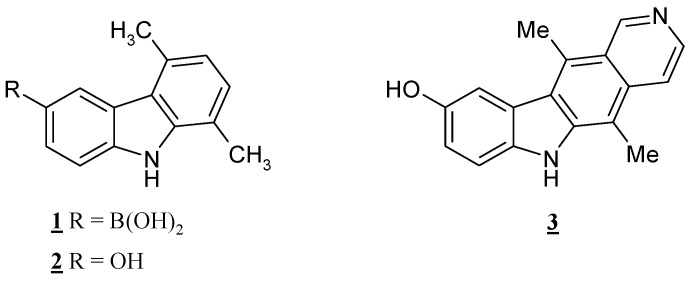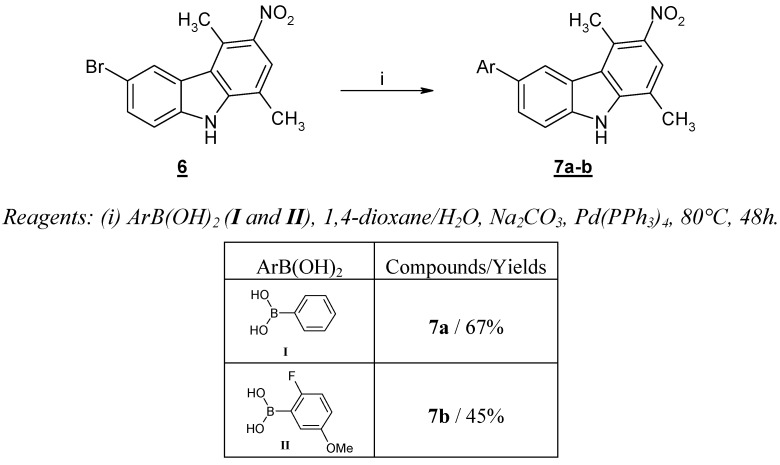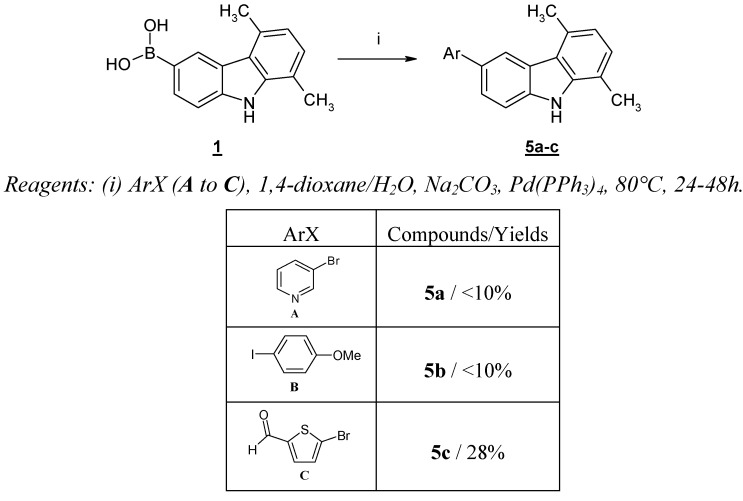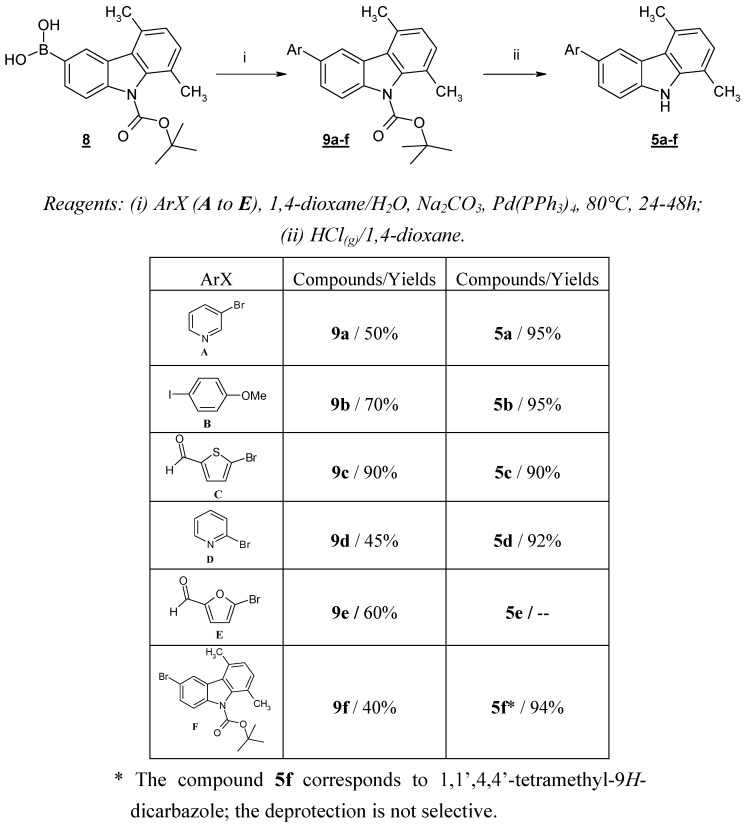Abstract
A synthetic method for the preparation of 6-aryl-1,4-dimethyl-9H-carbazoles involving a palladium catalyzed coupling reaction of 1,4-dimethyl-9H-carbazole-6-boronic acids and (hetero)aryl halides is described.
Keywords: Carbazole, ellipticine, boronic acid, cross-coupling reaction
Introduction
Several alkaloids based on a carbazole structure are known to possess interesting biological activities. Antitumor, antibacterial, anti-inflammatory, psychotropic and anti-histamine properties have been attributed to many of such compounds [1]. More recently, carbazoles have also been used as photoconductors, semiconductors and for their light-emitting properties, making them interesting organic tools for physics experiments [2]. The introduction of functional groups onto the carbazole scaffold is essential to generate compounds suitable for biological and physical investigations. Standard electrophilic substitution reactions on readily available 1,4-dimethyl-9H-carbazoles are usually unselective, taking place indifferently at positions 3, 6, or 9 [3,4], while methods for the selective substitution on a given position are lacking. We herein describe a method for the conversion of (5,8-dimethyl-9H-carbazol-3-yl)boronic acid, easily prepared starting from the known 6-bromo-1,4-dimethyl-9H-carbazole, to the corresponding 6-aryl-1,4-dimethyl-9H-carbazoles by a Suzuki-Miyaura cross-coupling reaction.
Many examples of Suzuki-Miyaura cross-coupling reactions between heterocyclic halides and phenyl boronic acids have been so far described [5,6], while the use of heteroaryl boronic acids or esters in the type of reactions is of limited utility [7,8]. Nevertheless, the reactivity of heteroaryl boronic derivatives continues to be of great interest. We reported in a previous paper the synthesis of carbazol-3-yl-boronic acid 1 (Figure 1), which was converted, via a hydroxydeboronation reaction, into the corresponding 3-hydroxy derivative 2 [9], a precursor of new analogs of the anticancer agent 9-hydroxyellipticine (3) [10,11,12].
Figure 1.
Carbazol-3-yl boronic acid 1, its 3-hydroxy derivative 2 and hydroxyellipticine (3).
Herein, we describe an efficient method involving a cross-coupling reaction, which would allow the preparation of a library of 6-aryl substituted carbazoles, as potential antitumoral agents. The key step is the reaction of (5,8-dimethyl-9H-carbazole-3-yl)boronic acid with (hetero)aryl halides to give 3-(hetero)arylcarbazole derivatives. Some typically used reaction conditions proved to be ineffective when applied to 6-bromo-1,4-dimethyl-9H-carbazole and (hetero)arylboronic acids.
Results and Discussion
The starting 6-bromo-1,4-dimethyl-9H-carbazole (4) was prepared by a known procedure [13,14]. Classic cross-coupling conditions (Na2CO3/Pd(PPh3)4/1,4-dioxane/water/80°C) [6] applied to the reaction of this compound with arylboronic acids I and II proved to be ineffective for the production of the desired 6-aryl-1,4-dimethyl-9H-carbazoles 5 (Scheme 1).
Scheme 1.
Cross-coupling reaction with 6-bromo-1,4-dimethyl-9H-carbazole 4.
Reagents: (i) ArB(OH)2 (I and II), 1,4-dioxane/ H2O, Na2CO3, Pd(PPh3)4, 80°C , 48h.
However a similar experimental procedure was effective when applied to the reaction of arylboronic acids I and II and 6-bromo-1,4-dimethyl-3-nitro-9H-carbazole (6), giving aryl-1,4-dimethyl-3-nitro-9H-carbazoles 7a and 7b, in reasonable yields (Scheme 2). As already described in numerous cases, the presence of a strong electron-withdrawing group favored the success of the reaction [15].
Scheme 2.
Cross-coupling reaction with 6-bromo-1,4-dimethyl-3-nitro-9H-carbazole (6).
Faced with these difficulties and also because the nitro group was considered undesirable, we have studied the reverse strategy, consisting in the preparation of the boronic acid 1. We have already described the synthesis of this N-unprotected boronic acid 1 [9] starting from 6-bromo-1,4-dimethyl-9H-carbazole (4).
Unfortunately, this boronic acid is a very poor partner in cross-coupling reactions and yields obtained with (hetero)aryl halides such as 3-bromopyridine (A) and p-iodoanisole (B) remained very modest (<10%), the exception being a heteroaryl halide bearing an electron withdrawing group such as 5-bromo-2-thiophenecarboxaldehyde (C), which gave the product 5c in 28% yield (Scheme 3).
Scheme 3.
Cross-coupling reaction with 5,8-dimethyl-9H-carbazole-3-boronic acid (1).
These failures prompted us to protect the nitrogen atom of 5,8-dimethyl-9H-carbazole-3-boronic acid (1). Thus, we prepared N-Boc-5,8-dimethyl-9H-carbazol-3-boronic acid (8), which was obtained after N-Boc-protection and successive lithiation-boronation of compound 4. We previously described the use of this reaction sequence for the preparation of 5,8-dimethyl-9H-carbazole-3-ol [9].
Compound 8 was then subjected to the Suzuki cross-coupling reaction with a variety of (hetero)aryl halides under standard conditions [6]. An aqueous solution of Na2CO3 and Pd(PPh3)4 was slowly added to a mixture of compound 8 and the appropriate (hetero)aryl halide in 1,4-dioxane at room temperature. The resulting mixture was then heated to reflux for the given time. After the usual work-up, compounds 9a-f were obtained in good yields. The N-deprotection of 9a-f was carried out with gaseous HCl in 1,4-dioxane, giving compounds 5a, 5b, 5c, 5d and 5f in quantitative yields (Scheme 4). We were unable to isolate compound 5e, probably due to the instability of the furfural moiety in an acidic medium.
Scheme 4.
Cross-coupling reaction with N-Boc-5,8-dimethyl-9H-carbazol-3-boronic acid (8).
Conclusions
We have found a good methodology to produce 6-aryl-1,4-dimethyl-9H-carbazoles using a N-protected 5,8-dimethyl-9H-carbazol-3-boronic acid. This methodology allows us to prepare new derivatives with potent interest in cancerology, especially biscarbazoles similar to Clausenamine A (Figure 2) [16,17,18,19].
Figure 2.
Clausenamine A.
Experimental
General
Commercial reagents were purchased from Aldrich, Acros Organics or Alfa Aesar and used without additional purification. Melting points were determined on a Kofler melting point apparatus. IR spectra were taken with a Perkin Elmer BX FT-IR. Mass spectra were taken on a JEOL JMS GCMate spectrometer at ionizing potential of 70 eV (EI) or were performed using a LC-MS Waters Alliance 2695 spectrometer (ESI+). 1H-NMR (400 MHz) was recorded on a JEOL Lambda 400 spectrometer; 13C-NMR were not recorded due to the low solubility of the compounds. Chemical shifts are expressed in parts per million downfield from tetramethylsilane as an internal standard. Thin layer chromatography (TLC) was performed on silica gel 60F-264 (Merck).
General procedure for the preparation of compounds 7a-b
The preparation of 1,4-dimethyl-3-nitro-6-phenyl-9H-carbazole (7a) is reported as a representative example: to a solution of 6-bromo-1,4-dimethyl-3-nitro-9H-carbazole (6, 1.50 g, 4.70 mmol) in 1,4-dioxane (70 mL), kept under an argon atmosphere, phenylboronic acid (I, 0.63 g, 5.17 mmol), Na2CO3 (1.25 g, 11.79 mmol) in H2O (3.50 mL) and Pd(PPh3)4 (0.30 g, 0.26 mmol) were added sequentially. The reaction mixture was heated to reflux for 48h, and then volatiles were evaporated under reduced pressure. The solid formed was recrystallized from acetonitrile to give 1,4-dimethyl-3-nitro-6-phenyl-9H-carbazole (7a). Yellow solid (67 % yield), mp = 226 °C; IR (KBr): 3451, 1584, 1521, 1302, 1301, 817, 758 cm-1; 1H-NMR (DMSO-d6) δ 11.94 (s, 1H, NH); 8.35 (s, 1H, H2); 7.86 (s, 1H, H5); 7.83-7.83 (m, 7H, H7, H8, C6H5); 2.96 (s, 3H, CH3); 2.55 (s, 3H, CH3); MS (EI) m/z (%): 316 (M+ •, 98), 271 (48) (M+ •-NO2).
1,4-Dimethyl-3-nitro-6-(2’-fluoro-5'-methoxyphenyl)-9H-carbazole (7b)
Prepared following the general procedure but employing 2-fluoro-5-methoxyphenylboronic acid (II) in place of I. Yellow solid (45 % yield), mp = 240 °C; IR (KBr): 3309, 1578, 1299, 1205, 1034, 810, 756 cm-1; 1H-NMR (DMSO-d6) δ 12.06 (s, 1H, NH); 8.36 (s, 1H, H2); 7.87 (s, 1H, H5); 7.71-7.65 (m, 2H, H8, H6’); 7.28-7.23 (m, 1H, H7); 7.17-7.14 (m, 1H, H4’); 6.95-6.93 (m, 1H, H3’); 3.80 (s, 3H, OCH3); 2.99 (s, 3H, CH3); 2.58 (s, 3H, CH3); MS (ESI+): 364 (M++1).
General procedure for the preparation of compounds 9a-f
The preparation of 1,4-dimethyl-6-pyridin-3-yl-9-tert-butoxycarbonyl-9H-carbazole (9a) is reported as a representative example: to a solution of 3-bromopyridine (A, 0.08 mL, 0.80 mmol) in 1,4-dioxane (50 mL), kept under an argon atmosphere, 9-tert-butoxycarbonyl-5,8-dimethyl-9H-carbazole-3-boronic acid (8, 0.30 g, 0.88 mmol), Na2CO3 (0.21 g, 2 mmol) in H2O (2 mL) and Pd(PPh3)4 (0.05 g, 0.04 mmol) were added sequentially. The reaction mixture was heated to reflux for 48 h, and then concentrated under reduced pressure. The solid residue was recrystallized from acetonitrile. Compound 9a was obtained as a light brown solid (50 % yield), mp = 167 °C; IR (KBr): 3435, 2972, 1731, 1458, 1288, 1246, 1145, 1084, 809, 721, 619 cm-1; 1H-NMR (DMSO-d6) δ 9.01 (s, 1H, H2’); 8.60-8.56 (m, 1H, H6’); 8.35 (s, 1H, H5); 8.20 (d, JH4’-5’ = 7.8 Hz, 1H, H4’); 8.11 (d, JH7-8 = 8.8 Hz, 1H, H7); 7.87 (d, JH8-7 = 8.8 Hz, 1H, H8); 7.53-7.50 (m, 1H, H5’); 7.24 (d, JH2-3 = 7.8 Hz, 1H, H2); 7.15 (d, JH3-2 = 7.8 Hz, 1H, H3); 2.84 (s, 3H, CH3); 2.40 (s, 3H, CH3); 1.67 (s, 9H, 3CH3); MS (EI) m/z (%): 372 (M+ •, 1), 316 (100) (M+ •- tBu), 272 (100) (M+ •- CO2tBu). MS (ESI+): 373 (M++1).
6-(4’-Methoxy-phenyl)-1,4-dimethyl-9-tert-butoxycarbonyl-9H-carbazole (9b)
Following a procedure identical to that described for 9a, but using 4-iodoanisole (B, 0.30 g, 1.34 mmol), 9b was obtained as a white solid (70 % yield), mp = 122 °C; IR (KBr): 2977, 1728, 1451, 1285, 1246, 1150, 1081, 804, 757, 697 cm-1; 1H-NMR (DMSO-d6) δ 8.36 (s, 1H, H5); 8.15 (d, JH7-8 = 8.8 Hz, 1H, H7); 7.89-7.83 (m, 2H, H8, H3’); 7.58-7.55 (m, 2H, H2’, H6’); 7.46-7.44 (m, 1H, H5’); 7.29 (d, JH2-3 = 7.8 Hz, 1H, H2); 7.20 (d, JH3-2 = 7.8 Hz, 1H, H3); 3.47 (s, 3H, OCH3); 2.89 (s, 3H, CH3); 2.45 (s, 3H, CH3); 1.71 (s, 9H, 3CH3); MS (EI) m/z (%): 401 (M+ •, 1), 271 (100) (M+ •- OCH3 - CO2tBu).
5-(5’,8’-Dimethyl-9’-tert-butoxycarbonyl-9’H-carbazol-3’-yl)-thiophene-2-carbaldehyde (9c)
Following a procedure identical to that described for 9a, but using 5-bromo-2-thiophene-carboxaldehyde (C, 0.27 g, 1.54 mmol) and a reflux time of 24 h, compound 9c was obtained as a yellow solid (90 % yield), mp = 168 °C; IR (KBr): 3428, 2971, 1739, 1657, 1428, 1225, 1149, 1061, 797, 665 cm-1; 1H-NMR (DMSO-d6) δ 9.90 (s, 1H, CHO); 8.38 (s, 1H, H4’) 8.07-8.05 (m, 2H, H1’, H3); 7.94 (d, J2-1 = 8.8 Hz, 1H, H2); 7.82 (d, JH4-3 = 3.9 Hz, 1H, H4); 7.24 (d, JH7-6 = 7.8 Hz, 1H, H7); 7.15 (d, JH6-7 = 7.8 Hz, 1H, H6); 2.81 (s, 3H, CH3); 2.40 (s, 3H, CH3); 1.66 (s, 9H, 3CH3); MS (ESI+): 405 (M++1).
1,4-Dimethyl-6-pyridin-2-yl-9-tert-butoxycarbonyl-9H-carbazole (9d)
Following a procedure identical to that described for 9a, but using 2-bromopyridine (D, 0.09 mL, 0.98 mmol), 9d was obtained as a light brown solid (45 % yield), mp = 212 °C; IR (KBr): 3370, 2977, 1701, 1457, 1290, 1252, 1149, 1088, 803, 780, 670 cm-1; 1H-NMR (DMSO-d6) δ 8.66 (s, 1H, H5); 8.08 (d, JH7-8 = 8.8 Hz, 1H, H7); 8.07-7.95 (m, 1H, H6’); 7.75 (d, JH8-7 = 8.8 Hz, 1H, H8); 7.71-7.68 (m, 2H, H4’, H3’); 7.20-715 (m, 1H, H5’); 7.10 (d, JH2-3 = 7.8 Hz, 1H, H2); 7.02 (d, JH3-2 = 7.8 Hz, 1H, H3); 2.72 (s, 3H, CH3); 2.41 (s, 3H, CH3); 1.62 (s, 9H, 3CH3); MS (ESI+): 373 (M++1).
5-(5’,8’-Dimethyl-9’-tert-butoxycarbonyl-9’H-carbazol-3’-yl)-furan-2-carbaldehyde (9e)
Following a procedure identical to that described for 9a, but using 5-bromo-2-furaldehyde (E, 0.27 g, 1.54 mmol) and a reflux time of 24 h, compound 9e was obtained as a yellow solid (60 % yield), mp = 110 °C; IR (KBr): 3430, 2975, 1744, 1672, 1450, 1285, 1149, 1084, 795 cm-1; 1H-NMR (DMSO-d6) δ 9.62 (s, 1H, CHO); 8.48 (s, 1H, H4’) 8.10 (d, JH1’-2’ = 8.8 Hz, 1H, H1’); 8.03 (d, JH2’-1’ = 8.79 Hz, 1H, H2’); 7.67 (d, JH3-4 = 3.9 Hz, 1H, H3); 7.34 (d, JH4-3 = 3.9 Hz, 1H, H4); 7.25 (d, JH7-6 = 7.8 Hz, 1H, H7); 7.16 (d, JH6-7 = 7.8 Hz, 1H, H6); 2.82 (s, 3H, CH3); 2.42 (s, 3H, CH3); 1.67 (s, 9H, t-Bu); MS (ESI+): 390 (M++1).
1,1’,4,4’-Tetramethyl-9-tert-butoxycarbonyl-9H-dicarbazole (9f)
Following the identical procedure to that described for 9f, but using 6-bromo-1,4-dimethyl-9-tert-butoxycarbonyl-9H-carbazole (F, 0.30 g, 0.80 mmol), 9f was obtained as a white solid (40 % yield), mp = 214 °C; IR (KBr): 3439, 2979, 1726, 1453, 1295, 1248, 1154, 1083, 804, 541 cm-1; 1H-NMR (DMSO-d6) δ 8.40 (s, 2H, H5, H5’); 8.20-8.10 (m, 2H, H7, H7’); 8.00-7.90 (m, 2H, H8, H8’); 7.10-7.30 (m, 4H, H2, H3, H2’, H3’); 2.85 (s, 6H, 2CH3); 2.42 (s, 6H, 2CH3); 1.68 (s, 18H, 6CH3); MS (EI) m/z (%): 588 (M+ •, 1), 388 (100) (M+ • - 2 CO2tBu).
General procedure for the deprotection of compounds 9a-f
The preparation of 1,4-dimethyl-6-pyridin-3-yl-9H-carbazole (5a) is reported as a representative example: to a mixture of 1,4-dioxane (70 mL) and gaseous HCl (saturated solution) cooled to 0 °C compound 9a (2.36 mmol) was added. The reaction mixture was heated to reflux for 48 h, then concentrated under reduced pressure. The oil formed residue was crystallized from acetonitrile. Compound 5a was obtained as a yellow solid (95 % yield), mp > 260 °C; IR (KBr): 3426, 2518, 1470, 1258, 790, 671 cm-1; 1H-NMR (DMSO-d6) δ 11.51 (s, 1H, NH); 9.30 (d, JH2’4’ = 2.4 Hz, 1H, H2’); 8.84 (dd, JH6’-5’ = 4.4 Hz, JH6’-4’ = 1.2 Hz, 1H, H6’); 8.77 (part A of AB system, JAB = 8.3 Hz, JHA-2’ = 2.4 Hz, JHA-6’ = 1.2 Hz, 1H, H4’); 8.49 (s, 1H, H5); 8.03 (part B of AB system, JAB = 8.3 Hz, JHB-6’ = 4.4 Hz, 1H, H5’); 7.85 (d, JH7-8 = 8.8 Hz, 1H, H7); 7.68 (d, JH8-7 = 8.8 Hz, 1H, H8); 7.13 (d, JH2-3 = 6.8 Hz, 1H, H2); 6.91 (d, JH3-2 = 6.8 Hz, 1H, H3); 3.42 (1H, NH+Cl-); 2.85 (s, 3H, CH3); 2.52 (s, 3H, CH3); MS (ESI+): 273 (M++1).
The following compounds were similarly obtained:
6-(4’-Methoxyphenyl)-1,4-dimethyl-9H-carbazole (5b). White solid (95 % yield), mp = 200 °C; IR (KBr): 3020, 1454, 1320, 1250, 1170, 1076, 799, 770, 676 cm-1; 1H-NMR (DMSO-d6) δ 10.00 (s, 1H, NH); 7.85 (s, 1H, H5); 7.58-7.56 (m, 2H, H2’, H6’); 7.40 (d, JH8-7 = 8.8 Hz, 1H, H8); 7.30 (d, JH7-8 = 8.8 Hz, 1H, H7); 7.05-7.00 (m, 2H, H3’, H5’); 6.98 (d, JH2-3 = 7.8 Hz, 1H, H2); 6.89 (d, JH3-2 = 7.8 Hz, 1H, H3); 3.85 (s, 3H, OCH3); 2.84 (s, 3H, CH3); 2.54 (s, 3H, CH3); MS (EI) m/z (%): 301 (M+ •, 100).
5-(5’,8’-Dimethyl-9’H-carbazol-3’-yl)-thiophene-2-carbaldehyde (5c). Yellow solid (90 % yield), mp = 262 °C; IR (KBr): 3435, 3267, 1634, 1430, 1241, 1058, 800, 669 cm-1; 1H-NMR (DMSO-d6) δ 11.58 (s, 1H, NH); 9.94 (s, 1H, CHO); 8,50 (s, 1H, H4); 8.11-8.10 (d, J3’‑4’= 3.9 Hz 1H, H3’); 7.89 (d, J2-1= 8.8 Hz 1H, H2); 7.83 (d, JH4’-3’ = 3.9 Hz 1H, H4’); 7.67 (d, J1-2 = 8.8 Hz 1H, H1); 7.19 (d, JH7-6 = 7.8 Hz, 1H, H7); 6.97 (d, JH6-7= 7.8 Hz, 1H, H6); 2.89 (s, 3H, CH3); 2.58 (s, 3H, CH3); MS (ESI+): 306 (M++1).
1,4-Dimethyl-6-pyridin-2yl-9H-carbazole (5d). White solid (92 % yield), mp > 260 °C; IR (KBr): 3424, 2516, 1468, 1270, 800, 673 cm-1; 1H-NMR (DMSO-d6) δ 11.48 (s, 1H, NH); 8.64 (s, 1H, H5); 8.10 (d, JH7-8 = 8.8 Hz, 1H, H7); 8.09-7.92 (m, 1H, H6’); 7.79 (d, JH8-7 = 8.8 Hz, 1H, H8); 7.70-7.69 (m, 2H, H4’, H3’); 7.22-718 (m, 1H, H5’); 7.13 (d, JH2-3 = 7.8 Hz, 1H, H2); 7.07 (d, JH3-2 = 7.8 Hz, 1H, H3); 3.43 (1H, NH+Cl-); 2.73 (s, 3H, CH3); 2.45 (s, 3H, CH3); MS (ESI+): 273 (M++1).
1,1’,4,4’-Tetramethyl-9H-dicarbazole (5f). White solid (94 % yield), mp = 254 °C; IR (KBr): 3454, 2987, 1457, 1300, 1254, 1187, 1067, 812, 570 cm-1; 1H-NMR (DMSO-d6) δ 10.20 (s, 2H, NH); 7.99-7.94 (m, 2H, H5, H5’); 7.59-7.38 (m, 4H, H7, H8, H7’, H8’); 7.15-6.98 (m, 4H, H2, H3, H2’, H3’); 2.85 (s, 6H, 2CH3); 2.55 (s, 6H, 2CH3); MS (EI) m/z: 388 (M+ •, 100).
Acknowledgements
The authors thank ‘Les Laboratories Servier’ and the ‘Conseil Regional de Basse-Normandie’ for their financial support and Dr. R. Legay for helpful in mass spectroscopy.
Footnotes
Sample Availability: Samples of the compounds are available from the authors.
References
- 1.Liu Z., Larock R.C. Synthesis of carbazoles and dibenzofurans via cross-coupling of o-iodoanilines and o-iodophenols with silylaryl triflates and subsequent Pd-catalyzed cyclization. Tetrahedron. 2007;63:347–355. doi: 10.1016/j.tet.2006.10.071. [DOI] [PMC free article] [PubMed] [Google Scholar]
- 2.Zhang Y., Wada T., Sasabe H. Carbazole photorefractive materials. J. Mater. Chem. 1998;8:809–828. doi: 10.1039/a705129h. [DOI] [Google Scholar]
- 3.Sundberg R.J. Comprehensive Heterocyclic Chemistry II. Pergamon; Oxford: 1996. [Google Scholar]
- 4.Kuwahara A., Nakano K., Nakani K. Double N-arylation of primary amines: carbazole synthesis from 2,2’-biphenyldiols. J. Org. Chem. 2005;70:413–419. doi: 10.1021/jo048472+. [DOI] [PubMed] [Google Scholar]
- 5.Stanforth S.P. Catalytic cross-coupling reactions in biaryl synthesis. Tetrahedron. 1998;54:263–303. doi: 10.1016/S0040-4020(97)10233-2. [DOI] [Google Scholar]
- 6.Suzuki A. Recent advances in the cross-coupling reactions of organoboron derivatives with organic electrophiles, 1995-1998. J. Organomet. Chem. 1999;576:147–168. doi: 10.1016/S0022-328X(98)01055-9. [DOI] [Google Scholar]
- 7.Tyrrell E., Brookes P. The synthesis and applications of heterocyclic boronic acids. Synthesis. 2003;4:469–483. [Google Scholar]
- 8.Abarca B., Ballesteros R., Blanco F., Bouillon A., Collot V., Domìnguez J.R., Lancelot J.C., Rault S. Synthesis of novel triazolopyridylboronic acids and esters. Study of potential application to Suzuki-type reactions. Tetrahedron. 2004;60:4887–4893. [Google Scholar]
- 9.Caruso A., Voisin-Chiret A.S., Lancelot J.C., Sinicropi M.S., Garofalo A., Rault S. Novel and efficient synthesis of 5,8-dimethyl-9H-carbazol-3-ol via a hydroxydeboronation reaction. Heterocycles. 2007;71:2203–2210. doi: 10.3987/COM-07-11113. [DOI] [Google Scholar]
- 10.Dugue B., Auclair C., Meunier B. Covalent binding of elliptinium acetate (NSC 264137) to nucleic acids of L1210 cells in culture. Cancer Res. 1986;46:3878–3833. [PubMed] [Google Scholar]
- 11.Moody D.L., Dyba M., Kosakowska-Cholody T., Tarasova N.I., Michejda C.J. Synthesis and biological activity of 5-aza-ellipticine derivatives. Bioorg. Med. Chem. Lett. 2007;17:2380–2384. doi: 10.1016/j.bmcl.2006.09.093. [DOI] [PMC free article] [PubMed] [Google Scholar]
- 12.Poljakovà J., Frei E., Gomez J.E., Aimovà D., Eckschlager T., Hrabèta J., Stiborovà M. DNA adduct formation by the anticancer drug ellipticine in human leukemia HL-60 and CCRF-CEM cells. Cancer Lett. 2007;252:270–279. doi: 10.1016/j.canlet.2006.12.037. [DOI] [PubMed] [Google Scholar]
- 13.Cranwell A., Saxton J.E. A synthesis of ellipticine. J. Chem. Soc. 1962:3482–3487. doi: 10.1039/jr9620003482. [DOI] [Google Scholar]
- 14.Lancelot J.C., Rault S., Robba M., Nguyen H.D. Efficient synthesis of 6H-pyrido[3,2-b]carbazole derivatives from 3-amino-1,4-dimethylcarbazole. Chem. Pharm. Bull. 1987;35:425–428. doi: 10.1248/cpb.35.425. [DOI] [Google Scholar]
- 15.Suzuki A., Brown H.C. Organic Syntheses Via Boranes Volume 3: Suzuki coupling. Aldrich Chemical Company; Milwaukee: 2003. [Google Scholar]
- 16.Wu T.-S., Huang S.-C., Wu P.-L. Carbazole-pyranocoumarin dimer and binary carbazole alkaloid from Clausena excavata. Tetrahedron Lett. 1996;37:7819–7822. doi: 10.1016/0040-4039(96)01741-8. [DOI] [Google Scholar]
- 17.Lin G., Zhang A. Synthesis of Optically Pure Clausenamine A and its Demethoxylated Analogs. Tetrahedron. 2000;56:7163–7171. doi: 10.1016/S0040-4020(00)00634-7. [DOI] [Google Scholar]
- 18.Zhang A., Lin G. The first synthesis of clausenamine A and cytotoxic activities of three biscarbazole analogues against cancer cells. Bioorg. Med. Chem. Lett. 2000;10:1021–1023. doi: 10.1016/S0960-894X(00)00158-X. [DOI] [PubMed] [Google Scholar]
- 19.Tasler S., Bringmann G. Biarylic biscarbazole alkaloids: occurrence, stereochemistry, synthesis, and bioactivity. Chem. Rec. 2002;2:114–126. doi: 10.1002/tcr.10014. [DOI] [PubMed] [Google Scholar]








